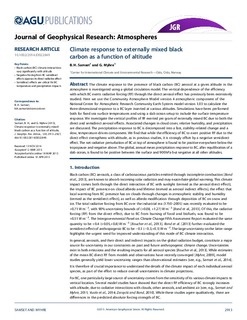| dc.contributor.author | Samset, Bjørn Hallvard | |
| dc.contributor.author | Myhre, Gunnar | |
| dc.date.accessioned | 2017-11-09T10:28:40Z | |
| dc.date.available | 2017-11-09T10:28:40Z | |
| dc.date.created | 2015-06-18T13:02:09Z | |
| dc.date.issued | 2015 | |
| dc.identifier.citation | Journal of Geophysical Research - Biogeosciences. 2015, 120 (7), 2913-2927. | |
| dc.identifier.issn | 2169-8953 | |
| dc.identifier.uri | http://hdl.handle.net/11250/2465182 | |
| dc.description | © 2015 American Geophysical Union. All Rights Reserved | |
| dc.description.abstract | The climate response to the presence of black carbon (BC) aerosol at a given altitude in the atmosphere is investigated using a global circulation model. The vertical dependence of the efficiency with which BC exerts radiative forcing (RF) through the direct aerosol effect has previously been extensively studied. Here we use the Community Atmosphere Model version 4 atmospheric component of the National Center for Atmospheric Research Community Earth System model version 1.03 to calculate the three-dimensional response to a BC layer inserted at various altitudes. Simulations have been performed both for fixed sea surface temperatures and using a slab ocean setup to include the surface temperature response. We investigate the vertical profiles of RF exerted per gram of externally mixed BC due to both the direct and semidirect aerosol effects. Associated changes in cloud cover, relative humidity, and precipitation are discussed. The precipitation response to BC is decomposed into a fast, stability-related change and a slow, temperature-driven component. We find that while the efficiency of BC to exert positive RF due to the direct effect strengthens with altitude, as in previous studies, it is strongly offset by a negative semidirect effect. The net radiative perturbation of BC at top of atmosphere is found to be positive everywhere below the tropopause and negative above. The global, annual mean precipitation response to BC, after equilibration of a slab ocean, is found to be positive between the surface and 900 hPa but negative at all other altitudes. | |
| dc.language.iso | eng | |
| dc.title | Climate response to externally mixed black carbon as a function of altitude | |
| dc.type | Peer reviewed | |
| dc.type | Journal article | |
| dc.description.version | publishedVersion | |
| dc.source.pagenumber | 2913-2927 | |
| dc.source.volume | 120 | |
| dc.source.journal | Journal of Geophysical Research - Biogeosciences | |
| dc.source.issue | 7 | |
| dc.identifier.doi | 10.1002/2014JD022849 | |
| dc.identifier.cristin | 1249171 | |
| dc.relation.project | Norges forskningsråd: 208277 | |
| dc.relation.project | Notur/NorStore: NN9188K | |
| cristin.unitcode | 7475,0,0,0 | |
| cristin.unitname | CICERO Senter for klimaforskning | |
| cristin.ispublished | true | |
| cristin.fulltext | original | |
| cristin.qualitycode | 2 | |
